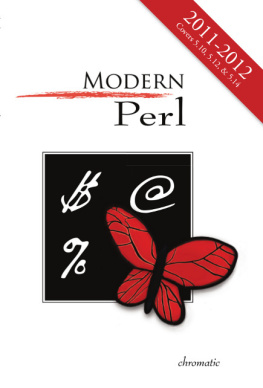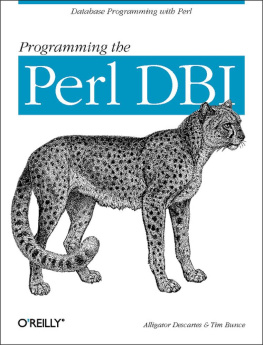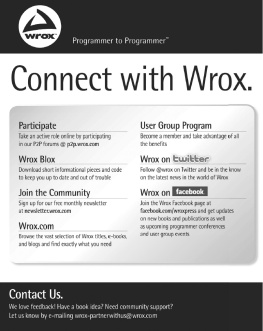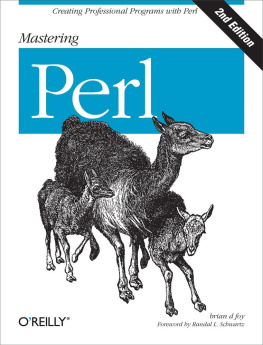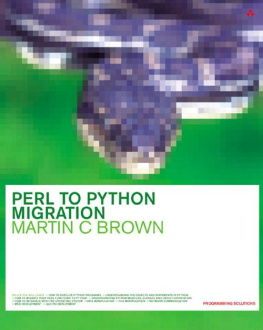Chromatic - Modern Perl
Here you can read online Chromatic - Modern Perl full text of the book (entire story) in english for free. Download pdf and epub, get meaning, cover and reviews about this ebook. genre: Computer. Description of the work, (preface) as well as reviews are available. Best literature library LitArk.com created for fans of good reading and offers a wide selection of genres:
Romance novel
Science fiction
Adventure
Detective
Science
History
Home and family
Prose
Art
Politics
Computer
Non-fiction
Religion
Business
Children
Humor
Choose a favorite category and find really read worthwhile books. Enjoy immersion in the world of imagination, feel the emotions of the characters or learn something new for yourself, make an fascinating discovery.
Modern Perl: summary, description and annotation
We offer to read an annotation, description, summary or preface (depends on what the author of the book "Modern Perl" wrote himself). If you haven't found the necessary information about the book — write in the comments, we will try to find it.
Modern Perl — read online for free the complete book (whole text) full work
Below is the text of the book, divided by pages. System saving the place of the last page read, allows you to conveniently read the book "Modern Perl" online for free, without having to search again every time where you left off. Put a bookmark, and you can go to the page where you finished reading at any time.
Font size:
Interval:
Bookmark:

Perl turns 23 years old later this year. The language has gone from a simple tool for system administration somewhere between shell scripting and C programming (Perl 1) to a powerful, general-purpose language steeped in a rich heritage (Perl 5) and a consistent, coherent, rethinking of programming in general intended to last for another 25 years (Perl 6).
Even so, most Perl 5 programs in the world take far too little advantage of the language. You can write Perl 5 programs as if they were Perl 4 programs (or Perl 3 or 2 or 1), but programs written to take advantage of everything amazing the worldwide Perl 5 community has invented, polished, and discovered are shorter, faster, more powerful, and easier to maintain than their alternatives.
Modern Perl is a loose description of how experienced and effective Perl 5 programmers work. They use language idioms. They take advantage of the CPAN. They're recognizably Perlish, and they show good taste and craftsmanship and a full understanding of Perl.
You can learn this too.
The Modern::Perl module is available from the CPAN. Install it yourself or replace it with:
use 5.010; use strict; use warnings;With these lines in every example program, Perl will warn you of dubious constructs and typos and will enable new features of Perl 5.10 through the feature pragma ((pragmas)). For now, assume these lines are always present. You will understand them soon.
Unless otherwise mentioned, code snippets always assume the basic skeleton of a program:
#!/usr/bin/perl use Modern::Perl; # example code here ...Other code snippets use testing functions such as ok(), like(), and is() ((testing)). That skeleton program is:
#!/usr/bin/perl use Modern::Perl; use Test::More; # example code here ... done_testing();The examples in this book work best with Perl 5.10.0 or newer; ideally at least Perl 5.10.1. Many examples will work on older versions of Perl 5 with modest changes, but you will have more difficulty with anything older than 5.10.0. This book also describes (but does not require the use of) features found in Perl 5.12.
You can often install a new version of Perl yourself. Windows users, download Strawberry Perl from http://www.strawberryperl.com/ . Users of other operating systems with Perl 5 already installed (and a C compiler and the other development tools), start by installing the CPAN module App::perlbrew (footnote: See http://search.cpan.org/perldoc?App::perlbrew for installation instructions.) .
perlbrew allows you to install and to manage multiple versions of Perl 5. By default, it installs them to your own home directory. Not only can you have multiple versions of Perl 5 installed without affecting the system Perl but you can also install any module you like into these directories without asking your system administrator for specific permission.
Should you learn Perl 5 or Perl 6? They share philosophy and syntax and libraries and community; they fill different niches. Learn Perl 5 if:
- You have existing Perl 5 code to maintain
- You need to take advantage of CPAN modules
- Your deployment strategy requires rigorous stability
Learn Perl 6 if:
- You're comfortable managing frequent upgrades
- You can afford to experiment with new syntax and features
- You need new features only available in Perl 6
- You can contribute to its development (whether patches, bug reports, documentation, sponsorship, or other resources)
In general, Perl 5 development is conservative with regard to the core language. For good or for ill, change occurs slowly. Perl 6 is more experimental, as it considers finding the best possible design more important than keeping old code working. Fortunately, you can learn and use both languages (and they interoperate to an ever-improving degree).
This book discusses Perl 5. To learn more about Perl 6, see http://perl6.org/ , try Rakudo ( http://www.rakudo.org/ ), and refer to the book Using Perl 6, also published by Onyx Neon Press.
This book would not have been possible in its current form without questions, comments, suggestions, advice, wisdom, and encouragement from many, many people. In particular, the author and editor would like to thank:
John SJ Anderson, Peter Aronoff, Lee Aylward, Alex Balhatchet, var Arnfjr Bjarmason, Matthias Bloch, John Bokma, Vasily Chekalkin, Dmitry Chestnykh, E. Choroba, Paulo Custodio, Felipe, Shlomi Fish, Jeremiah Foster, Mark Fowler, John Gabriele, Andrew Grangaard, Bruce Gray, Ask Bjrn Hansen, Tim Heaney, Robert Hicks, Michael Hind, Mark Hindess, Yary Hluchan, Mike Huffman, Curtis Jewell, Mohammed Arafat Kamaal, James E Keenan, Yuval Kogman, Jan Krynicky, Jeff Lavallee, Moritz Lenz, Jean-Baptiste Mazon, Josh McAdams, Gareth McCaughan, John McNamara, Shawn M Moore, Alex Muntada, Carl Msak, Chris Niswander, Nelo Onyiah, Chas. Owens, ww from PerlMonks, Jess Robinson, Dave Rolsky, Gabrielle Roth, Andrew Savige, Lorne Schachter, Dan Scott, Alexander Scott-Johns, Phillip Smith, Christopher E. Stith, Mark A. Stratman, Bryan Summersett, Audrey Tang, Scott Thomson, Ben Tilly, Sam Vilain, Larry Wall, Colin Wetherbee, Frank Wiegand, Doug Wilson, Sawyer X, David Yingling, Marko Zagozen, harleypig, hbm, and sunnavy.
Any errors are the fault of the author's own stubbornness.
Perl is a language for getting things done. It's flexible, forgiving, and malleable. In the hands of a capable programmer, it can accomplish almost any task, from one-liner calculations and automations to multi-programmer, multi-year projects and everything in between.
Perl is powerful, and modern Perl--Perl which takes advantage of the best knowledge, deepest experience, and reusable idioms of the global Perl community--is maintainable, fast, and easy to use. Perhaps most importantly, it can help you do what you need to do with little frustration and no ceremony.
Perl is a pragmatic language. You, the programmer, are in charge. Rather than manipulating your mind and your problems to fit how the language designer thinks you should write programs, Perl allows you to solve your problems as you see fit.
Perl is a language which can grow with you. You can write useful programs with the knowledge that you can learn in an hour of reading this book. Yet if you take the time to understand the philosophies behind the syntax, semantics, and design of the language, you can be far more productive.
First, you need to know how to learn more.
One of Perl's most useful and least appreciated features is the perldoc utility. This program is part of every complete Perl 5 installation (footnote: You may have to install an additional package on a free GNU/Linux distribution or another Unix-like system; on Debian and Ubuntu this is perl-doc.) . It displays the documentation of every Perl module installed on the system--whether a core module or one installed from the Comprehensive Perl Archive Network (CPAN)--as well as thousands of pages of Perl's copious core documentation.
If you prefer an online version, http://perldoc.perl.org/ hosts recent versions of the Perl documentation. http://search.cpan.org/ displays the documentation of every module on the CPAN. Windows users, both ActivePerl and Strawberry Perl provide a link in your Start menu to the documentation.
Next pageFont size:
Interval:
Bookmark:
Similar books «Modern Perl»
Look at similar books to Modern Perl. We have selected literature similar in name and meaning in the hope of providing readers with more options to find new, interesting, not yet read works.
Discussion, reviews of the book Modern Perl and just readers' own opinions. Leave your comments, write what you think about the work, its meaning or the main characters. Specify what exactly you liked and what you didn't like, and why you think so.


